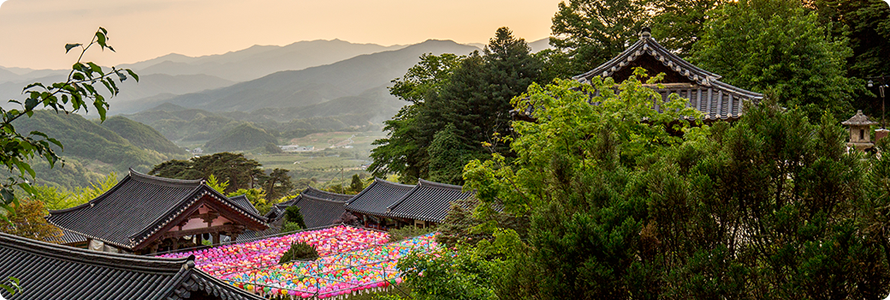Buddhist Mountain Monasteries in Korea
Buseoksa Temple
Buseoksa Temple
Introduction
Natural Environment
History
Temple Layout
Cultural Properties
Information
Natural Environment of Bonghwangsa Temple
- Bonghwangsan Mountain (819m) forms the boundary between Buseok-myeon and Murya-myeon, Bonghwa-gun in Yeongju-si, Gyeongsangbuk-do Province. While it forms a part of the Sobaeksan National Park, it is actually a part of Taebaeksan Mountain, and the sign on the Iljumun Gate of Buseoksa even reads, “Taebaeksan Buseoksa.” The Baekdudaegan Mountain range comprised of Taebaeksan forms Guryongsan, Okdongbong, Seondalsan and Sobaeksan toward its west, and the range extending from Seondalsan leads to Bonghwansan Mountain. The mountain is called Bonghwansan (lit. Phoenix Mountain) because its shape is similar to that of the phoenix. According to Yeojidoseo records, it was also called Wangsan (lig. Mountain of Kings) because it contains an old fortress site, and also because King Gongmin of Goryeo climbed this mountain in refuge. However, the source is unclear. Experts in geomancy refer to the geographical conditions of the Buseoksa Temple site as “Seobongporanhyeong.” The wings of the phoenix, which were called Cheongnyongbaekho (blue dragon, white tiger), under the principles of geomancy, have mostly been turned into orchards.
 Buseoksa Temple
Buseoksa Temple
- As for the overall layout of the temple, the land becomes wider toward the top, as though a large bird is spreading its wings. The natural incline of the mountainside was used advantageously to have taller buildings toward the top. Thus, when you stand before Muryangsujeon, situated midway toward the peak of Bonghwansan Mountain, you can see the peaks of the Sobaeksanmaek Mountain Range, without any obstacles in your view.
- As for its natural environment, the temple is surrounded by an oak forest, with trees that are 30 to 40 years old, and it is seated against the backdrop of a large pine tree forest. There aren’t any tree forests along the entryway between Iljumun and Cheonwangmun gates, but it is lined with common wildflowers such as pansies, false-starwort, deadnettle, dandelion, tetterwort, wayside speedwell, and corydalis. The surrounding area has mostly been developed into orchards and farmlands.
 Entryway of Buseoksa Temple
Entryway of Buseoksa Temple
- Although the temple itself boasts a long history, there aren’t any old trees in particular. Within the temple grounds, there are sand pear, Manchurian lemon and chestnut trees, but most are less than 50 years old. Within the temple grounds, there are sand pear, Manchurian lemon and chestnut trees, but most are less than 50 years old. To explain its origin, it’s been said that the cane used by Great Monk Uisang, the founder of Buseoksa, came to life after being planted into the ground here. According to Taengniji, Great Monk Uisang stated, “After I leave this place, branches and leaves will grow from this cane. If this tree does not wither and die, I, too, will not die.” The tree species is “Caragana sinica,” which is a deciduous shrub distributed in the central and northern regions of Korea as well as the northeastern region of China and Mongolia. It is resistant against pests and can survive even in cold temperatures and with lack of light. It is also highly adaptable to various types of soil. This is probably the reason it has been able to survive for hundreds of years under the eaves of Josadang, which lacks water and sunlight. Gyeongsangbuk-do Province began protecting the tree in 1982 (Provincial Tree No. 11-70), while Buseoksa has installed a barbed-wire fence around it for protection.
-
 Seonbihwa (Caragana sinica) which transformed from the cane of Great Monk Uisang
Seonbihwa (Caragana sinica) which transformed from the cane of Great Monk Uisang
